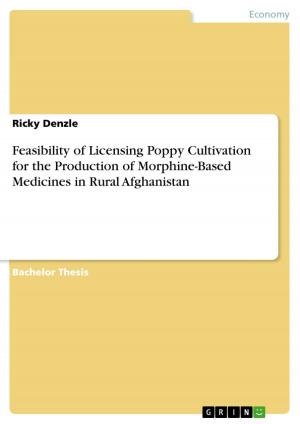African American English - properties and features
properties and features
Nonfiction, Entertainment, Drama, Anthologies| Author: | Florian Paulus | ISBN: | 9783638070713 |
| Publisher: | GRIN Publishing | Publication: | June 30, 2008 |
| Imprint: | GRIN Publishing | Language: | English |
| Author: | Florian Paulus |
| ISBN: | 9783638070713 |
| Publisher: | GRIN Publishing |
| Publication: | June 30, 2008 |
| Imprint: | GRIN Publishing |
| Language: | English |
Seminar paper from the year 2008 in the subject English Language and Literature Studies - Linguistics, grade: 2,0, University of Dusseldorf 'Heinrich Heine', 6 entries in the bibliography, language: English, abstract: Content 1.Introduction..............................................................................3 2.The roots of African American English............................................3 3.Features..................................................................................5 3.1Phonetics..............................................................................5 3.1.1.The 'th' in AAE.........................................................5 3.1.2The Consonant Cluster education(CCR)..............................7 3.2AAE as a non-rhotic dialect........................................................9 3.3 Grammatical Features...............................................................10 3.3.1Negation..................................................................10 3.3.2Time Reference.........................................................11 3.4 BIN.................................................................................12 4. Conclusion 5. Works cited 6. Appendix 2. The roots of African American English Geneva Smitherman answers the question where the 'black language and style' came from with the beginning of slavery in Colonial America. In 1619 a Dutch vessel brought with a cargo twenty Africans to Jamestown, Virginia to work there as 'indentured servants'. The blacks where mostly brought from countries of the African West Coast over the so called 'West passage' to the Colonies in America. They were forced to work on the cash crop plantations, harvesting tobacco, cotton, Sugar and coffee. Because there is, of course, no tape recordings of the language the slaves spoke, linguists have 'to rely on reconstructions of black talk based on indirect evidence [...] written reproductions of the dialect in Journals, letters and diaries by whites [...]. African slaves developed a pidgin, what Smitherman calls a 'language of transaction' used to communicate between themselves and the whites. This pidgin developed over the years as a widespread Creole among slaves. It consisted of the West-African words which were substituted little by little by English words but with the same basic language structures of West- African Languages. These Languages for example allow sentence constructions without the verb to be. According to that, sentences like 'He going' still occur today in African American Vernacular English environments. Because the American settlers did not speak Standard British English as they came from Ireland, Scotland, and Germany etc. the slaves adopted certain features of the pidgin the settlers spoke to their Creole. Especially in the South, where a lot of Irish settled, a typical feature of Irish phonology is wide spread. Words like red and hat are pronounced with diphthongs, as 're?d' and 'h?at', respectively, which the blacks adopted to their language.
Seminar paper from the year 2008 in the subject English Language and Literature Studies - Linguistics, grade: 2,0, University of Dusseldorf 'Heinrich Heine', 6 entries in the bibliography, language: English, abstract: Content 1.Introduction..............................................................................3 2.The roots of African American English............................................3 3.Features..................................................................................5 3.1Phonetics..............................................................................5 3.1.1.The 'th' in AAE.........................................................5 3.1.2The Consonant Cluster education(CCR)..............................7 3.2AAE as a non-rhotic dialect........................................................9 3.3 Grammatical Features...............................................................10 3.3.1Negation..................................................................10 3.3.2Time Reference.........................................................11 3.4 BIN.................................................................................12 4. Conclusion 5. Works cited 6. Appendix 2. The roots of African American English Geneva Smitherman answers the question where the 'black language and style' came from with the beginning of slavery in Colonial America. In 1619 a Dutch vessel brought with a cargo twenty Africans to Jamestown, Virginia to work there as 'indentured servants'. The blacks where mostly brought from countries of the African West Coast over the so called 'West passage' to the Colonies in America. They were forced to work on the cash crop plantations, harvesting tobacco, cotton, Sugar and coffee. Because there is, of course, no tape recordings of the language the slaves spoke, linguists have 'to rely on reconstructions of black talk based on indirect evidence [...] written reproductions of the dialect in Journals, letters and diaries by whites [...]. African slaves developed a pidgin, what Smitherman calls a 'language of transaction' used to communicate between themselves and the whites. This pidgin developed over the years as a widespread Creole among slaves. It consisted of the West-African words which were substituted little by little by English words but with the same basic language structures of West- African Languages. These Languages for example allow sentence constructions without the verb to be. According to that, sentences like 'He going' still occur today in African American Vernacular English environments. Because the American settlers did not speak Standard British English as they came from Ireland, Scotland, and Germany etc. the slaves adopted certain features of the pidgin the settlers spoke to their Creole. Especially in the South, where a lot of Irish settled, a typical feature of Irish phonology is wide spread. Words like red and hat are pronounced with diphthongs, as 're?d' and 'h?at', respectively, which the blacks adopted to their language.















